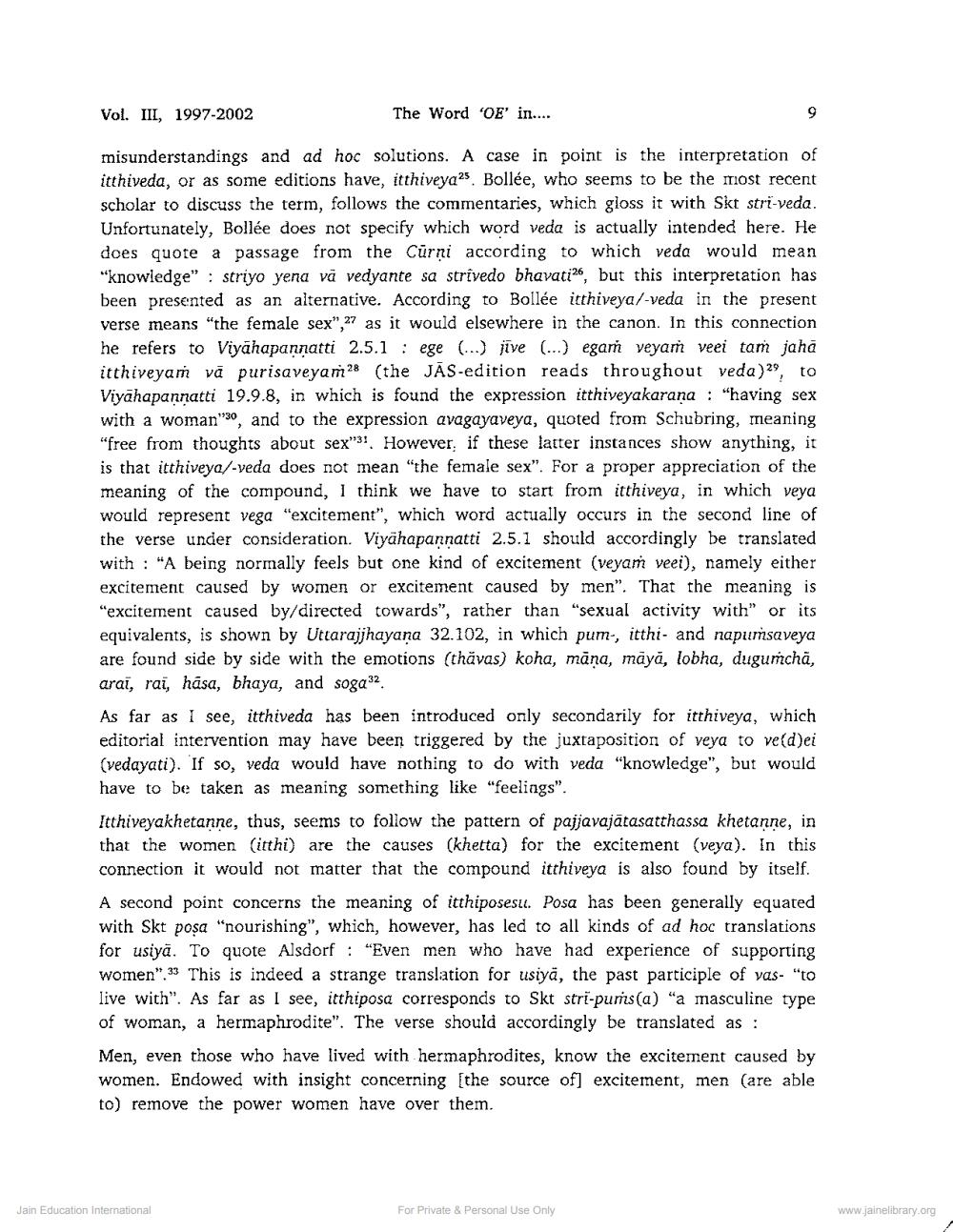Book Title: Word OE in Some Canonical Jaina Texts Author(s): Hermen Tieken Publisher: Z_Nirgrantha_1_022701.pdf and Nirgrantha_2_022702.pdf and Nirgrantha_3_022703.pdf View full book textPage 7
________________ Vol. III, 1997-2002 The Word 'OE' in.... 28 misunderstandings and ad hoc solutions. A case in point is the interpretation of itthiveda, or as some editions have, itthiveya 25. Bollée, who seems to be the most recent scholar to discuss the term, follows the commentaries, which gloss it with Skt stri-veda. Unfortunately, Bollée does not specify which word veda is actually intended here. He does quote a passage from the Curni according to which veda would mean "knowledge" striyo yena và vedyante sa strivedo bhavati", but this interpretation has been presented as an alternative. According to Bollée itthiveya/-veda in the present verse means "the female sex",27 as it would elsewhere in the canon. In this connection he refers to Viyahapannatti 2.5.1 ege (...) live (...) egar veyaṁ veei tam jaha itthiveyam va purisaveyam (the JAS-edition reads throughout veda), to Viyahapannatti 19.9.8, in which is found the expression itthiveyakarana : "having sex with a woman, and to the expression avagayaveya, quoted from Schubring, meaning "free from thoughts about sex". However, if these latter instances show anything, it is that itthiveya/-veda does not mean "the female sex". For a proper appreciation of the meaning of the compound, I think we have to start from itthiveya, in which veya would represent vega "excitement", which word actually occurs in the second line of the verse under consideration. Viyahapanṇatti 2.5.1 should accordingly be translated with "A being normally feels but one kind of excitement (veyam veei), namely either excitement caused by women or excitement caused by men". That the meaning is "excitement caused by/directed towards", rather than "sexual activity with" or its equivalents, is shown by Uttarajjhayana 32.102, in which pum-, itthi- and napumisaveya are found side by side with the emotions (thāvas) koha, māņa, māyā, lobha, duguncha, arai, rai, hāsa, bhaya, and soga 9 As far as I see, itthiveda has been introduced only secondarily for itthiveya, which editorial intervention may have been triggered by the juxtaposition of veya to ve(d)ei (vedayati). If so, veda would have nothing to do with veda "knowledge", but would have to be taken as meaning something like "feelings". Itthiveyakhetanne, thus, seems to follow the pattern of pajjavajätasatthassa khetanne, in that the women (itthi) are the causes (khetta) for the excitement (veya). In this connection it would not matter that the compound itthiveya is also found by itself. A second point concerns the meaning of itthiposesu. Posa has been generally equated with Skt posa "nourishing", which, however, has led to all kinds of ad hoc translations. for usiya. To quote Alsdorf "Even men who have had experience of supporting women".33 This is indeed a strange translation for usiya, the past participle of vas- "to live with". As far as I see, itthiposa corresponds to Skt stri-pums (a) "a masculine type of woman, a hermaphrodite". The verse should accordingly be translated as : Jain Education International Men, even those who have lived with hermaphrodites, know the excitement caused by women. Endowed with insight concerning [the source of] excitement, men (are able to) remove the power women have over them. For Private & Personal Use Only www.jainelibrary.orgPage Navigation
1 ... 5 6 7 8 9 10 11 12 13 14 15 16
